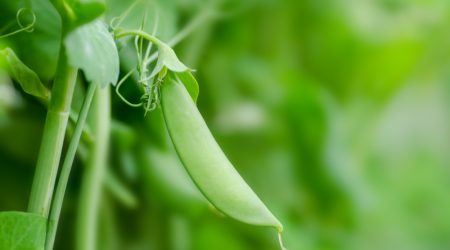One type of wrinkled pea currently under scientific scrutiny contains a high amount of so-called ‘resistant’ starch
This less-branched form of starch is digested more slowly and does not lead to the high blood sugar spike associated with the starches found almost universally in snacks and fast foods.
Recent nutritional studies reveal that food products made using seeds from wrinkled peas have a dramatic effect in generating lower blood sugar spikes following ingestion by healthy volunteers.
The study compared the effects of wrinkled pea seed food products with those derived from wild-type (round-seeded) pea seeds which has much less ‘resistant’ starch (the control foods).
The two types of pea are near-isogenic – that is the plants and seeds from which the foods were derived are genetically near-identical, apart from the effects of the gene controlling seed appearance.
The exciting findings are part of a collaborative research programme involving the Imperial College London, the John Innes Centre and Quadram Institute.
Initial results of the multi-disciplinary study show that by eating products developed from the wrinkled pea seeds, there is a dramatic reduction in the blood glucose spike over the two hours following meal intake, compared with the control food.
The full results of the study are due to be published this spring, but there is growing excitement from the evidence gathered so far. If the same results extend to people at risk of developing Type-2 diabetes, the researchers hope that the findings could play a significant part in tackling a prevalent public health issue.
Professor Claire Domoney of the John Innes Centre says;
Eating starch that is rapidly digested, for example in cakes and sweets, is bad for us because digestion of these products leads to a rapid and high glucose spike in our blood. The negative impact of this is that the pancreas struggles to make the insulin to cope with these spikes. In people who are prone to Type-2 diabetes this pancreatic stress is greater.
The World Health Organisation states that the global prevalence of Type-2 diabetes has risen from 4.7% in 1980 to 8.5% in 2014. A total of 422 million people suffer from this modern disease which accounts for 90% of all cases of diabetes according to the charity Diabetes UK. The charity calculates that the cost of treating diabetes could reach £17 billion by 2035.
People who have Type-2 diabetes have higher levels of blood sugar because their bodies do not produce or use insulin normally. The problem can be alleviated by healthier diets, being more active and losing weight.
The tantalising prospect that emerges from the results of the collaboration is that a major public health issue could be addressed by persuading food production companies to make more use of the wrinkled pea as an ingredient in foods, including snacks that are consumed every day by millions of people.
Partners in the project took the contrasting pea seeds and developed a range of products, including hummus, biscuits and soups, which were used in intervention trials in a scientifically meaningful way.
Currently, the wrinkled-seeded type of pea, though used in immature form as a vegetable having a low concentration of total starch, is not used as a mature dry seed across the food industry. Targeting the healthy snack markets may be one way of ensuring that the benefits of the mature seed are felt more widely across the population.
Professor Domoney explains, “One question which arises is: can we substitute the pea flour with non-resistant starch that is used currently as an ingredient across the food industry? Doing this could impact a range of food products, possibly without impacting on product quality or taste. It’s a question of how we can incorporate this nutritionally beneficial food into people’s diets. It’s a case of improving health by stealth.”
A major aim now is to encourage breeding programmes to produce new pea varieties which contain the resistant starch trait, and which are suitable for producing mature pea seeds to be harvested on a large scale.
“We’re not claiming that we’re going to solve a major health problem by providing foods enriched in pea products to everybody. The science is based on a model system that shows what can be done by linking plant genetics with nutritional interventions,” says Professor Domoney.
“There are other considerations such as the land mass required in the UK and rotational needs if there was a huge escalation in demands by the industry for pea flour replacements. But this project provides very nice data that can impact ultimately on improving food for health. In principle, the trait can be generated within other food crops and tested for its effects in a similar way.”




